Mazda CX-80 2025 review
Mazda’s all-new CX-80 will launch in Australia late this year, adding a second seven-seat SUV to the family, though in a more compact size than the flagship CX-90
Mazda’s new large-architecture platform is, as promised, spawning a whole family of models powered by electrified combustion powertrains for multiple global markets. In the US, there will be the CX-70 and CX-90 large five- and seven-seat twins, while Japan and Europe will only see the smaller CX-60 and this new extended-wheelbase CX-80.
Australia’s strong demand for Mazda products, however, will result in a unique local line-up offering all four CX SUV models in the same showroom by the end of 2024.
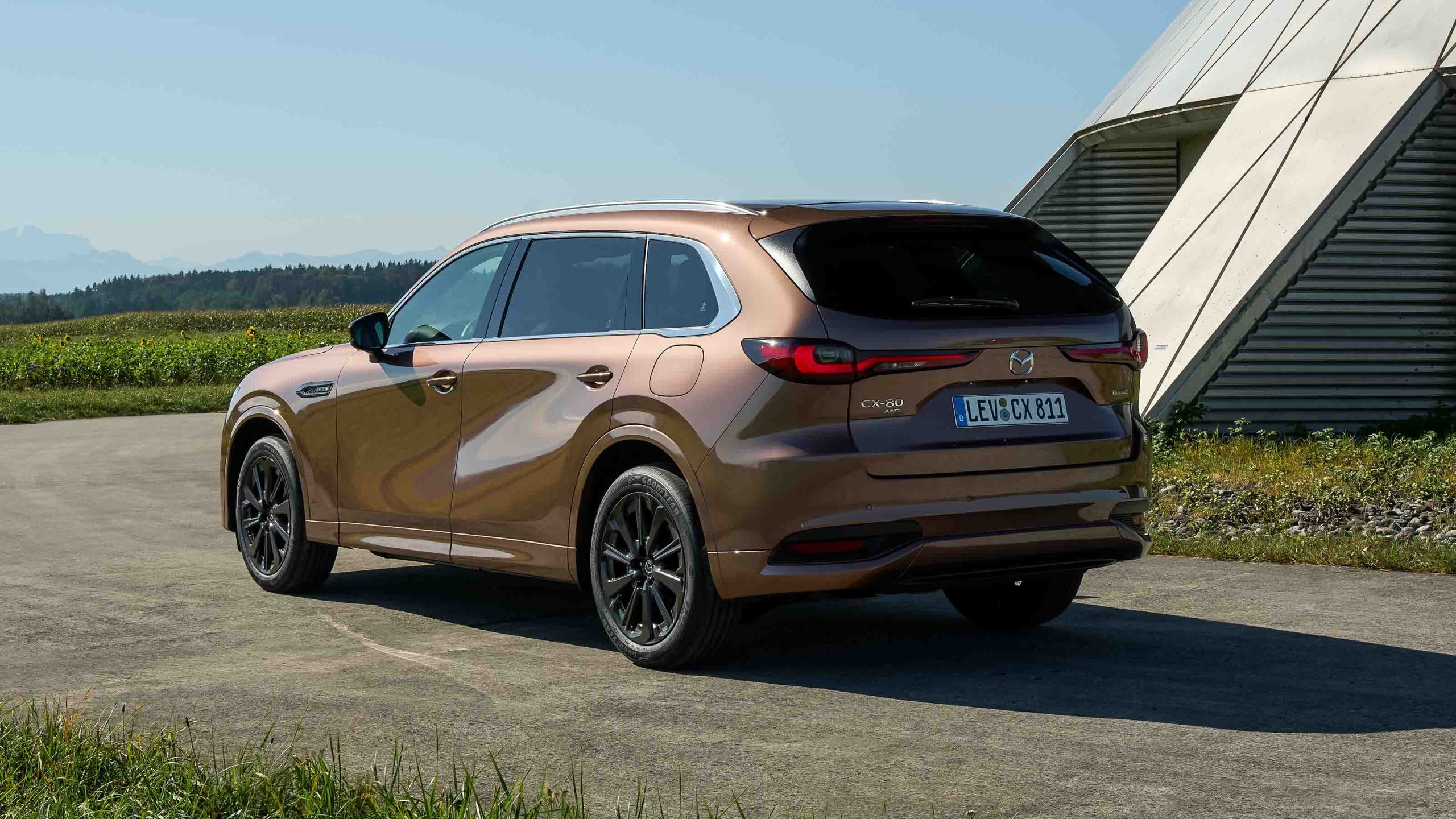
The five-seat CX-70 will be the last to arrive, beaten by this new-generation CX-8 replacement called CX-80. And much like the CX-8 (which was essentially a CX-5 L, with a lengthened wheelbase and rear end), the CX-80 combines the front half of a CX-60 with a longer and more accommodating back half.
We had a first drive of this new model at its international launch in Germany to get a better understanding of how it’s going to fit into Mazda Australia’s growing line-up and what is different about it.
What are the CX-80’s features and options for the price?
Three CX-80 variants will be coming to Australia, matching the existing CX-60’s engine line-up. That includes a choice of 3.3-litre turbocharged straight-six engines fed by either petrol or diesel, and a 2.5-litre four-cylinder petrol paired to a plug-in hybrid system.
As Mazda believes the CX-80 PHEV will be the most popular option in Australia, that’s the variant we focused on.
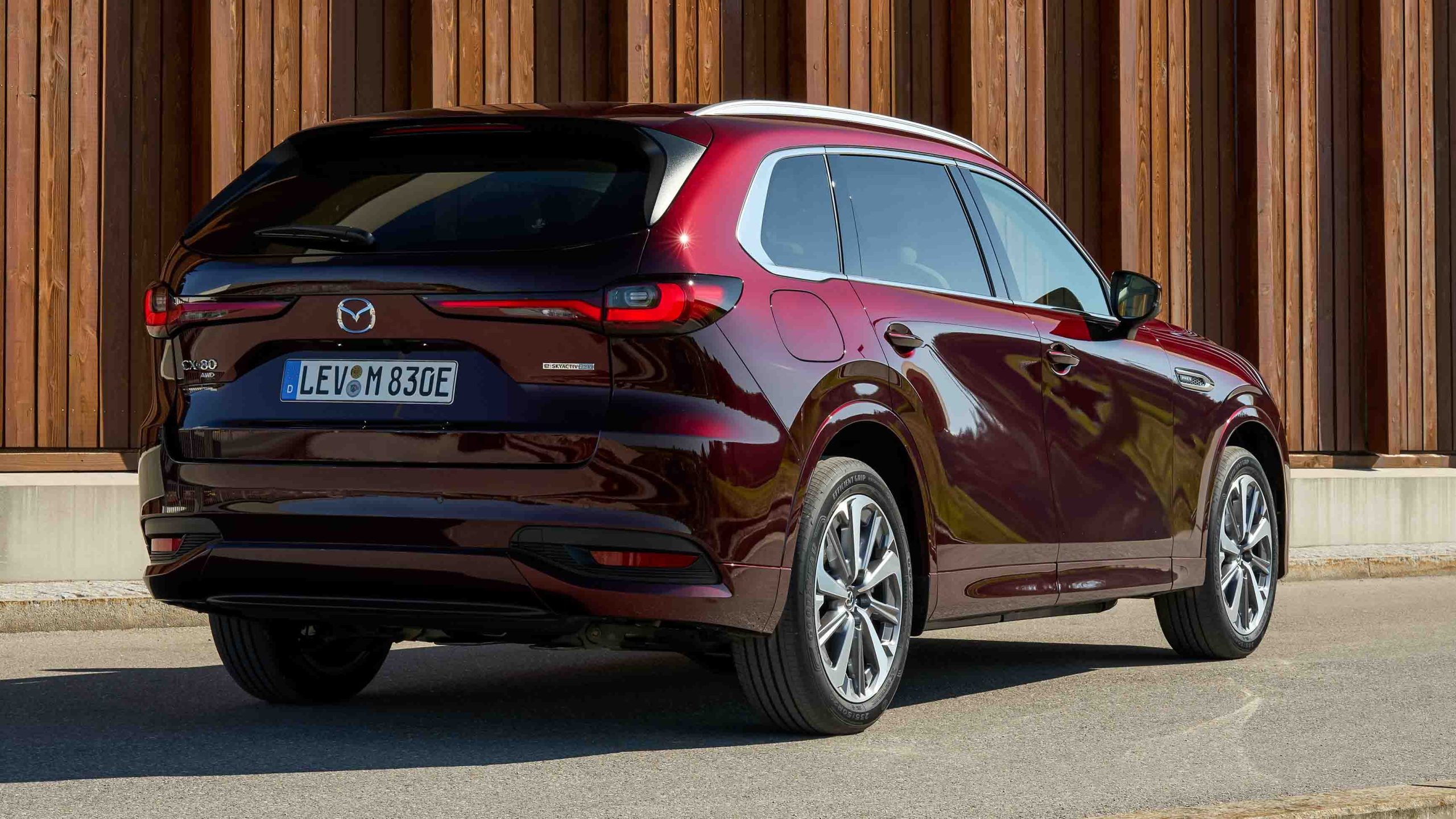
It has a 17.8kWh lithium-ion battery and a 129kW electric motor integrated into the transmission for impressive combined outputs of 241kW and 500Nm, or a pure EV mode with 129kW/270Nm and a range of up to 60km.
Regardless of the engine, all are paired with an eight-speed automatic transmission and Mazda’s i-Activ all-wheel-drive system.
At the more luxurious end of the spectrum, a more premium optional Homura interior will be offered, adding a dark interior theme with high-quality leather and contrasting patterns on the seats and dash, paired with matching wood.
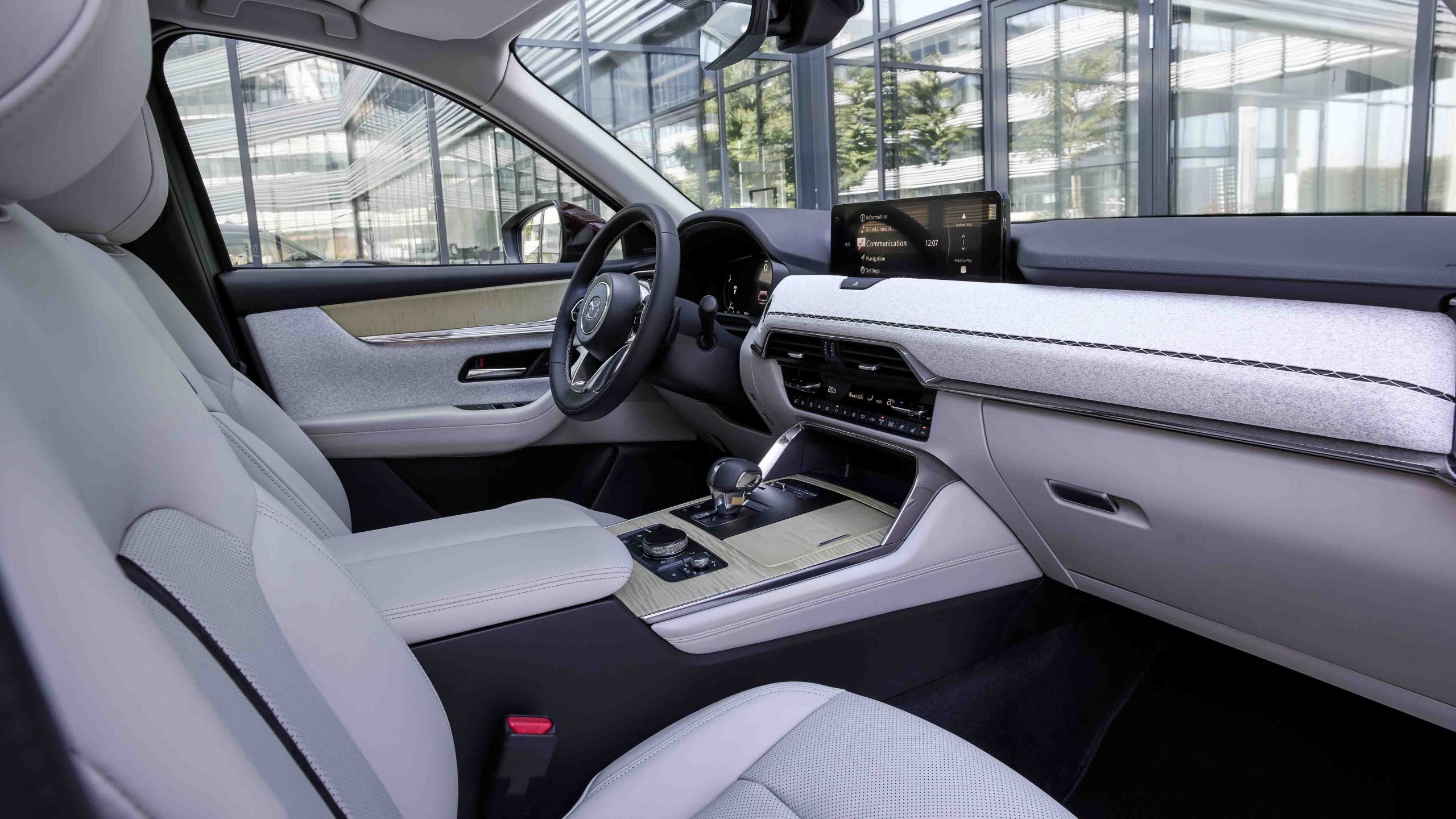
It also adds a large panoramic tilt-and-slide sunroof which may be also offered as a standalone option. The lighter-toned Takumi option is unfortunately not being offered in Australia.
Model line-up specification will be detailed closer to the CX-80’s launch at the end of the year, though expect a similar range to the CX-60 which is offered in three grades – Evolve, GT and Azami.
Pricing is also yet to be determined but a starting point of just under $60,000 is understood to be a reasonable speculation.

All versions get three rows of seating, including a standard seven-seat configuration or an optional ‘captain’s chairs’ six-seat arrangement.
The six-seater has two more luxurious seats in the second row – separated by a centre console containing more storage, cupholders and armrests to match the level of comfort in the front row.
There’s a second six-seat version available in Europe minus the centre console, which allows occupants to ‘walk’ through to the third row, which is a really convenient loading option and would probably work well for many families, though it won’t be available in Australia.

Second-row passengers also have their own climate-control panel complete with physical switches and a digital display. Third-row occupants have USB-C charging and their own small bottle holders.
Our test car rolled on 20-inch alloy wheels with Goodyear SUV tyres and was dressed up in a lovely shade of Artisan Red, although the hero colour (Melting Copper) looks absolutely stunning in European sunlight.
How does the CX-80 PHEV drive?
Let’s start with the known stuff. Mazda’s fresh straight-six engines have been strong performers in both the CX-60 and CX-90 SUVs, with excellent power and torque delivery, as well as fuel efficiency in both diesel and petrol configurations – and that doesn’t change in the CX-80.
The same goes for the plug-in hybrid, which is much faster than the diesel six in particular, with the boost of electric torque making it feel livelier and more eager.
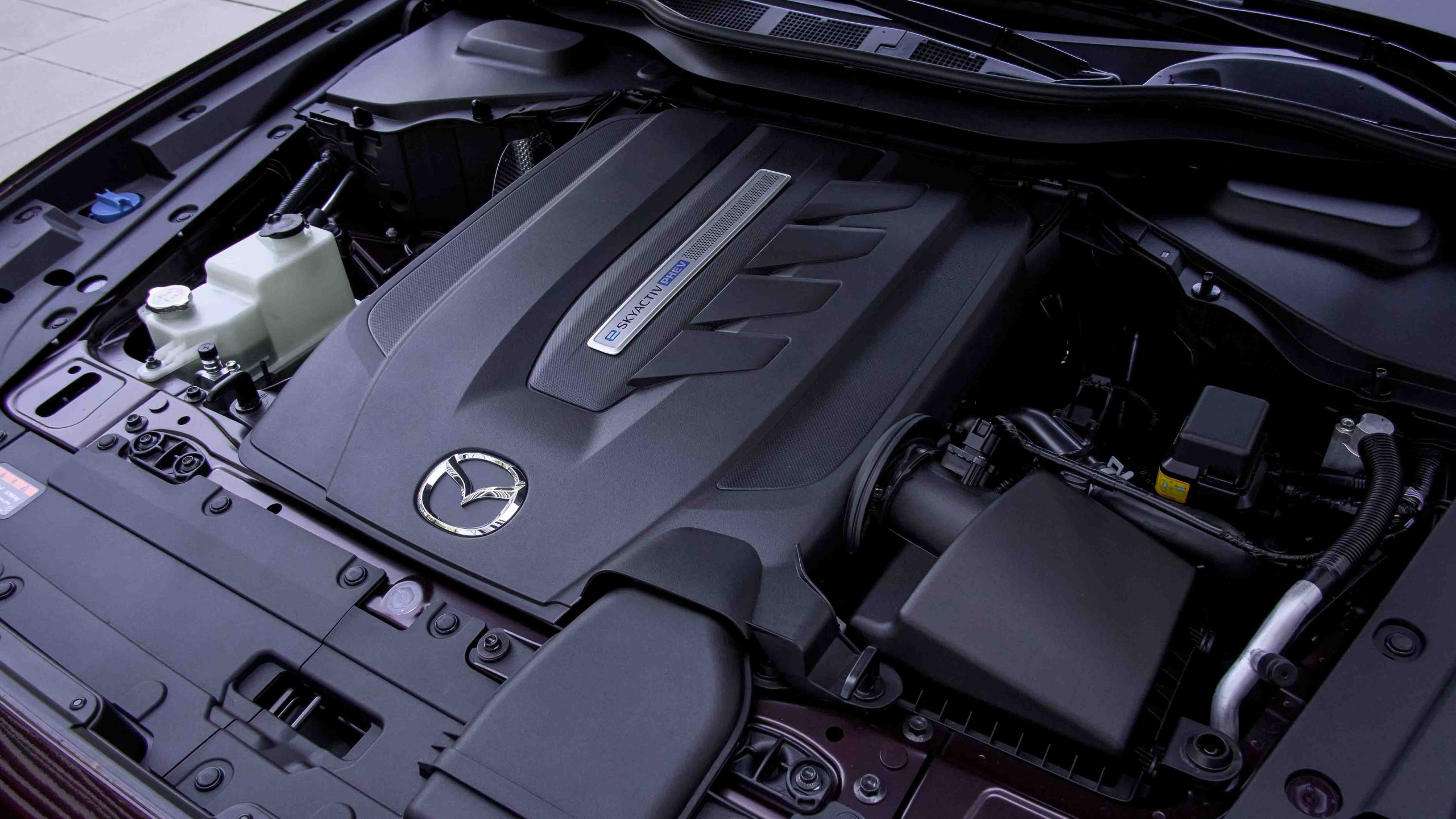
Mazda quotes a combined fuel economy figure of 1.6L/100km but on a longer run with the battery charge exhausted, our test car managed mid-to-high sixes.
We also rate the pairing of an eight-speed automatic transmission highly, and the clever torque-converter-replacing clutch system works with urgency and responsiveness. There’s a little bit of noise from the electromechanical components but not offensively so, and it’s only audible because the CX-80’s cabin is so quiet at low speeds.
The engine is a refined cruiser, though acceleration is strong and it makes a good noise when working harder. The PHEV’s regenerative brake-pedal feel is nicely progressive and even preferable to the full-combustion versions.
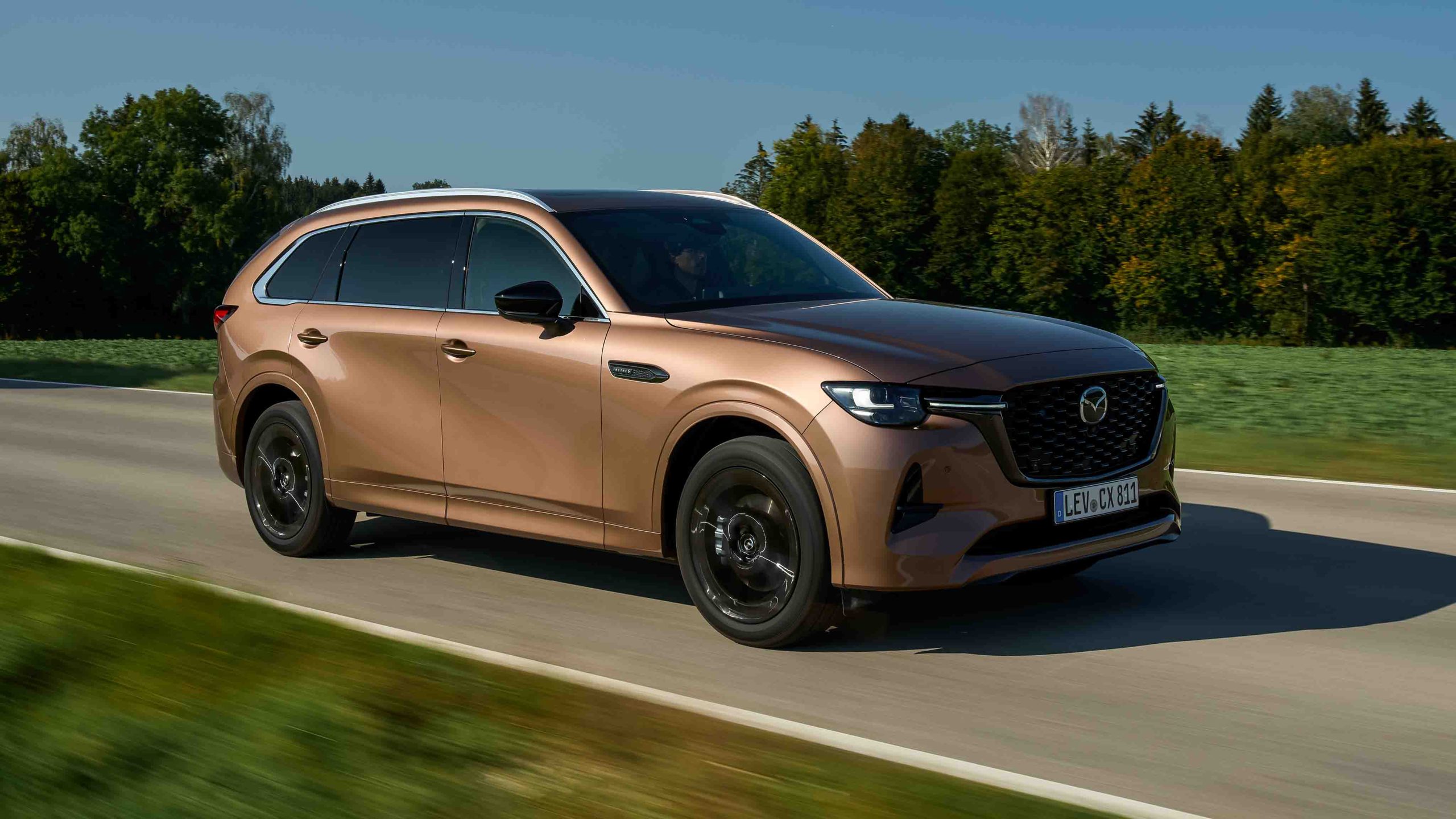
At higher speeds there were a few curious vibrations creeping in. One felt like a rear wheel was out of balance, while the other was a strange buzzing vibration from the steering wheel which felt a little like a lane-departure warning or fine-surface corrugation, but wasn’t.
Neither anomalies have been detected in Australian testing of models on the same platform so let’s hope both are limited to these early-production CX-80s in Europe.
The elephant in the room is the CX-80’s chassis which, if simply a re-run of the initial CX-60 and CX-90 tuning, would miss an opportunity to be significantly better. Thankfully, Mazda has been fully receptive to criticism and the CX-80 has an improved ride.
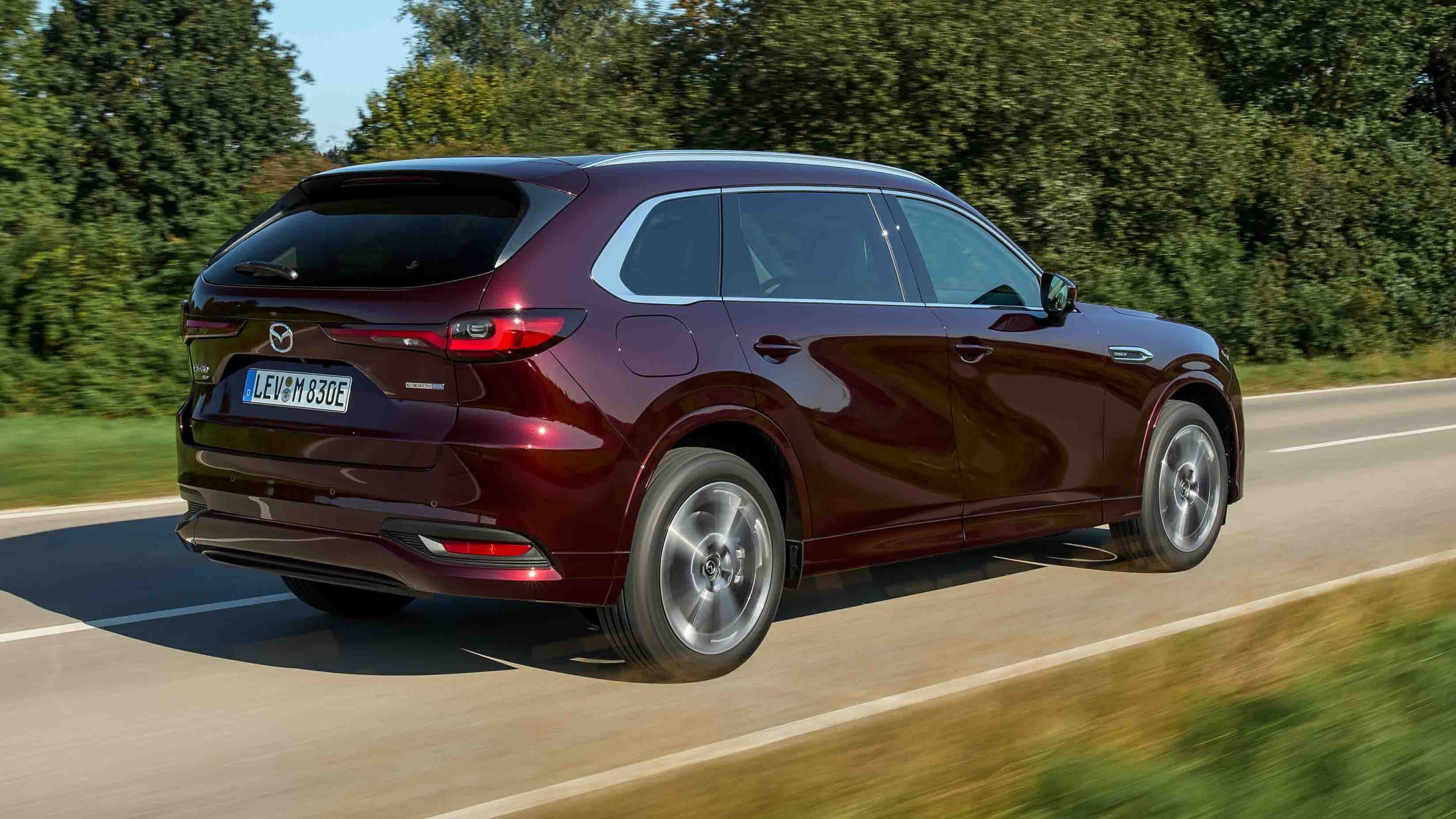
The rear anti-roll bar has been deleted, the rear springs have been softened and the dampers uprated in an attempt to tame the sudden and overly firm ride. An improvement in the diesel is subtle, with a bit of fussiness still remaining over finer imperfections, if demonstrating a more refined nature over larger bumps and bigger hits.
The PHEV, however, is better still, most likely due to its heavier kerb weight.
There’s still a little stiffness in the secondary ride, but the primary ride is noticeably better at dealing with large bumps and the CX-80 displays the most compliant ride quality yet in any Mazda SUV from the large-architecture family.
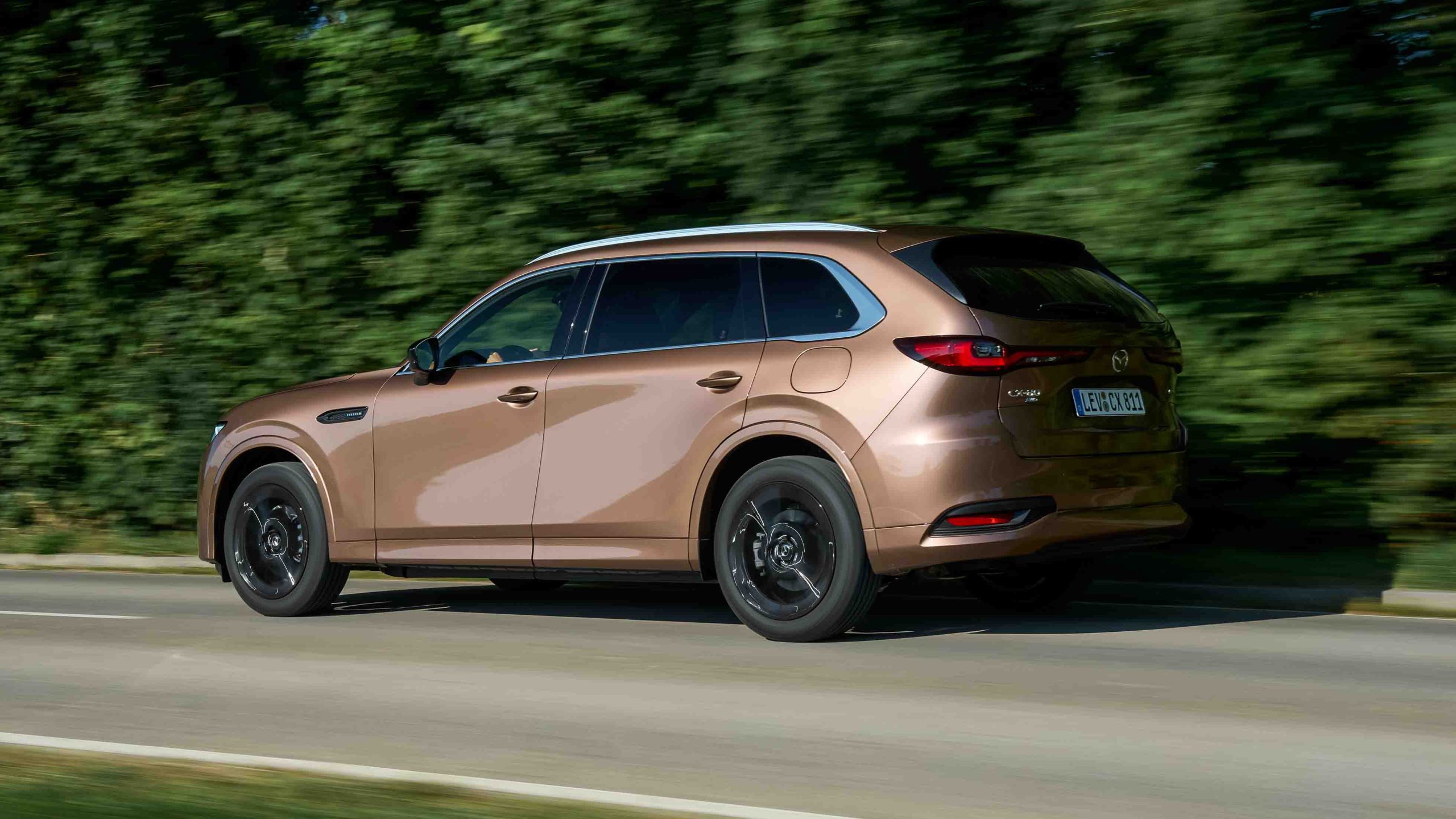
Unfortunately, we didn’t find any twisty German roads to evaluate the CX-80’s dynamic breadth, which is a shame as the suspension revisions will most certainly have an effect on roadholding and body control.
While early signs indicate the steering is still precise, with good initial turn-in, a few bends highlight increased body roll, so watch this space for a full analysis on Australian soil.
What is the CX-80’s interior and tech like?
A 12.3-inch digital driver’s instrument cluster is standard, with slick graphics and a number of customisable screens to display whatever information is deemed the most useful or important.
In the plug-in-hybrid version, it provides two separate gauges for battery and fuel level, which makes it easy to see zero-emissions and low-emissions driving options at a glance.
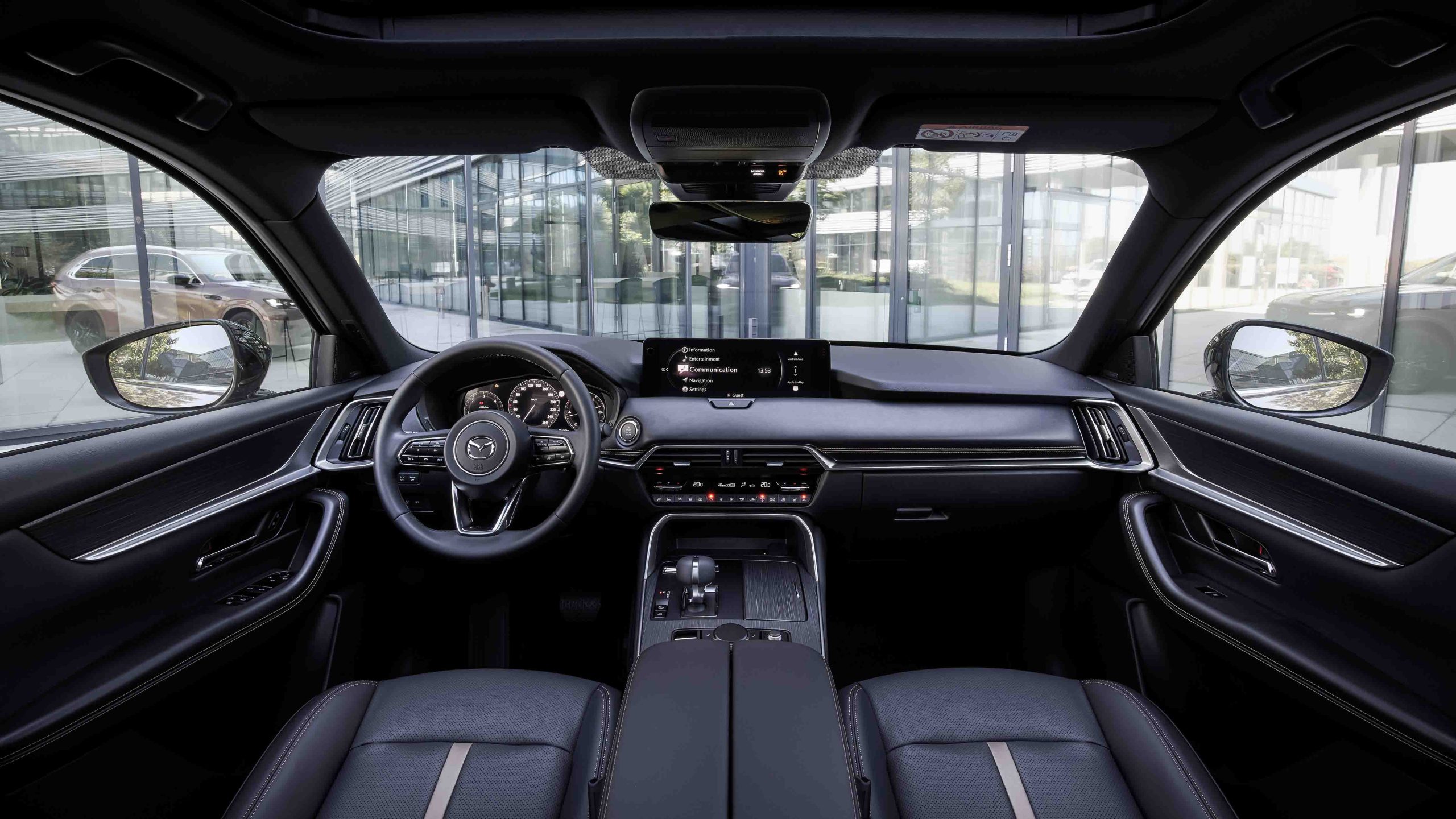
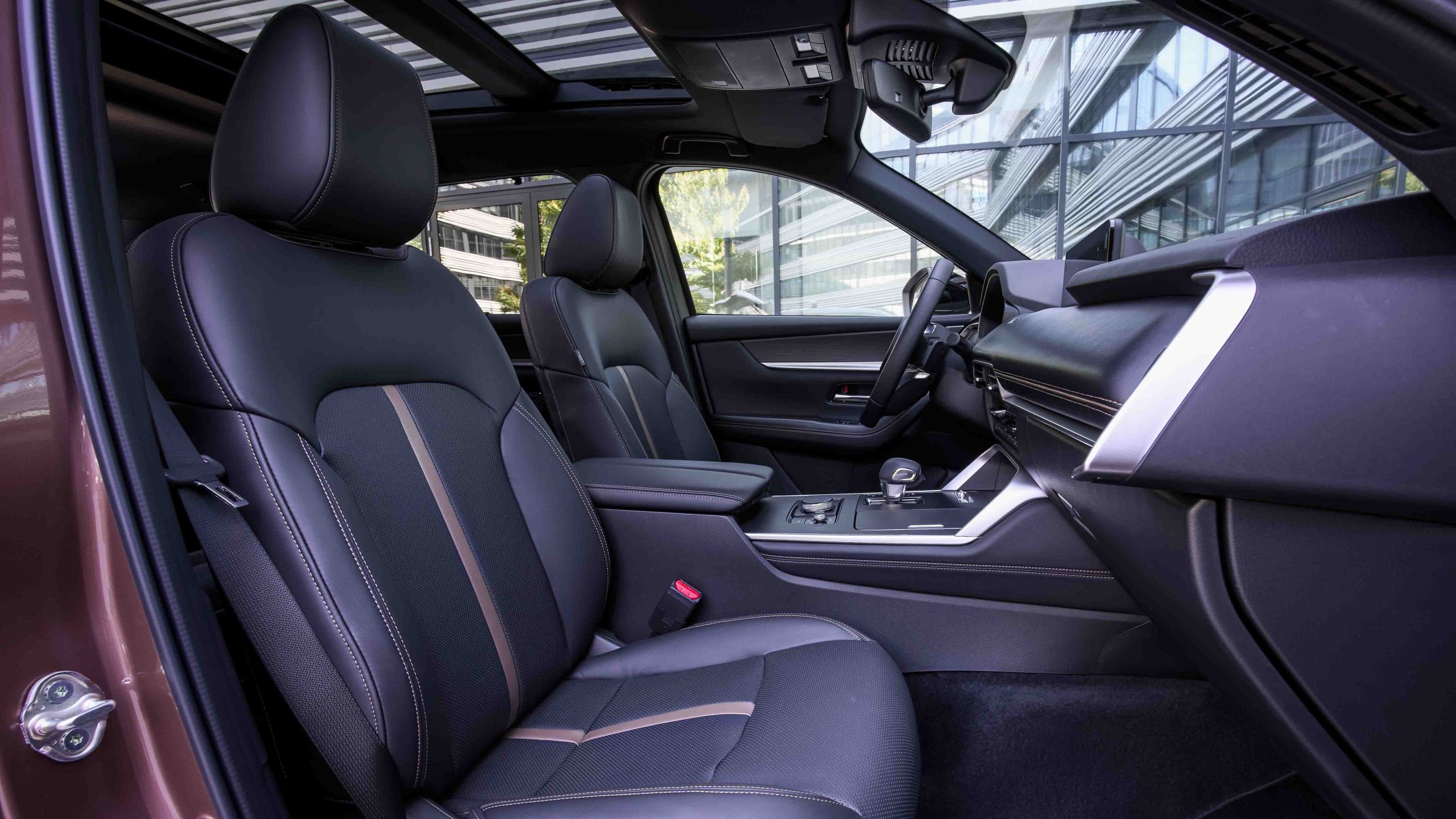
We also like the cool dynamic graphics displayed by the gauge ‘cluster’ when the driving mode is switched through one of the Normal, Sport, Off-Road, Towing and EV choices.
While the central information and entertainment screen is noticeably faster in operation compared with the previous-generation operating system, its refresh seems rather insubstantial and it’s a bit dated in appearance.
Also, the screen is not touch sensitive unless mirroring a smartphone in either wireless Android Auto or Apple CarPlay.
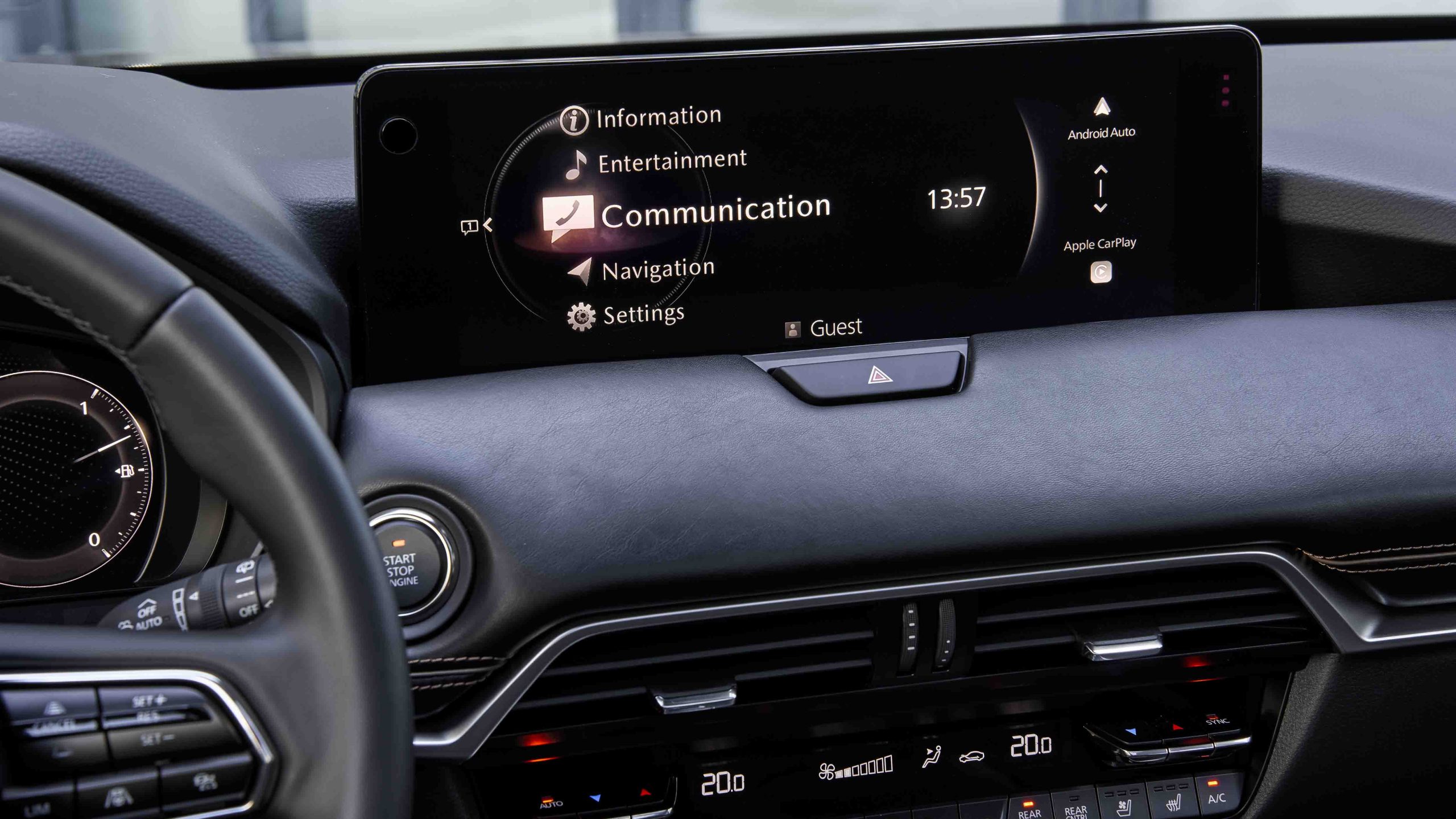
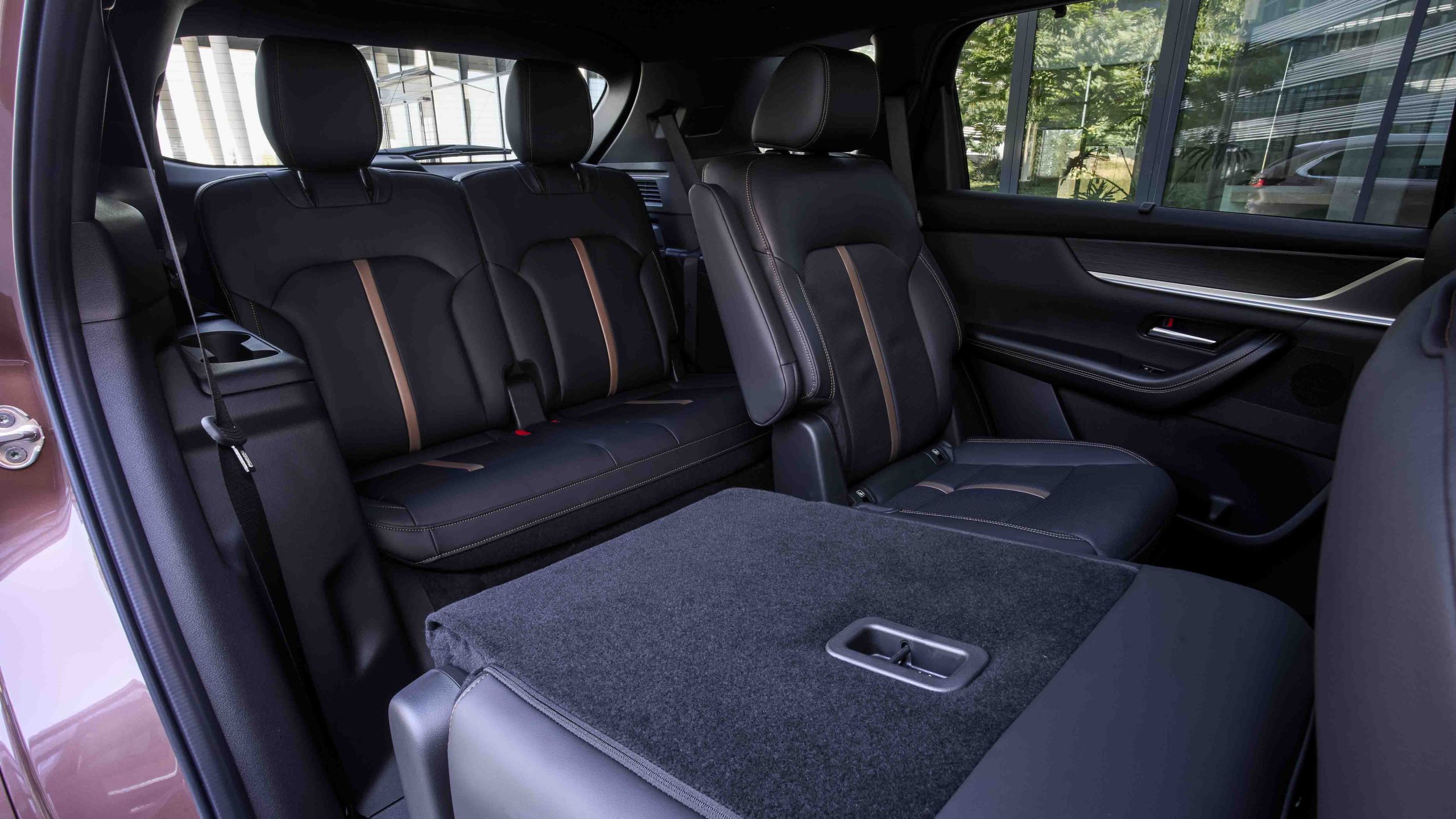
Sure, it’s likely most people will connect that way, but it’s also safe to say a good number won’t, and features such as the excellent hybrid navigation are a bit clunky to use with the central control dial.
Most of the CX-80’s stretched wheelbase can be found in the second row, with longer doors and boosted legroom.
There’s a lot of space for row-two passengers and the lengthened side windows offer an excellent view out.
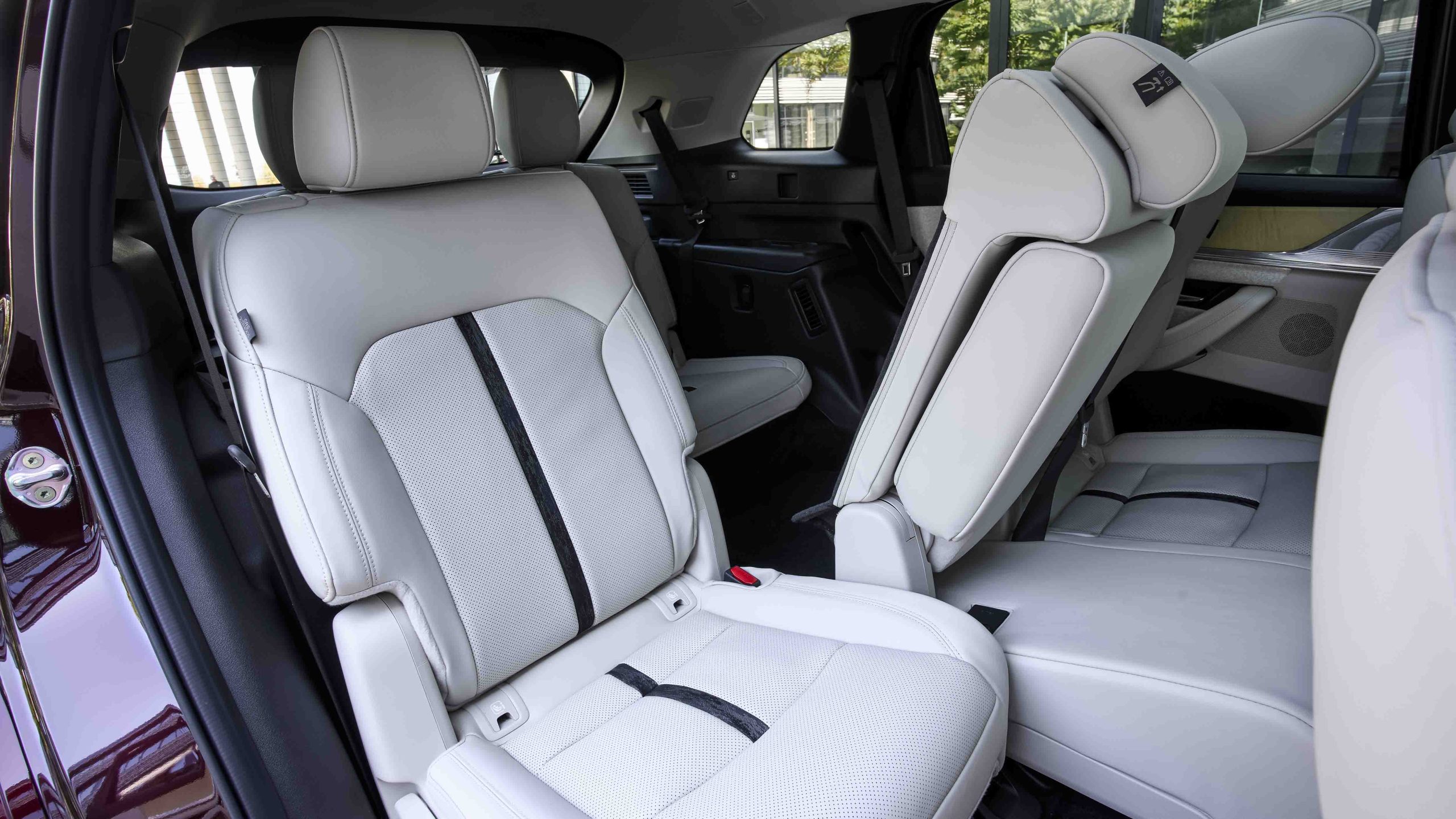
Second-row seating can be adjusted fore/aft across a 120mm range, allowing extra room in the third row for taller people or simply the maximum luxury experience in the second row.
One example we piloted had been decked out with the light and bright Takumi leather interior, with beech timber highlights and a cool dash stitching design, but after too many errant ballpoint pens and grubby children, Mazda Australia says this risky interior option won’t be offered.

The CX-80 also features a large boot with 258 litres of space even with all three rows of seating in place, or 687 litres in the five-seat configuration.
In seven-seat versions, the second row can be stowed to release up to 1971 litres, but it’s not clear if the six-seat CX-80 can achieve the same trick with its more substantial second-row chairs.
Is the CX-80 a safe car?
The CX-80 has not yet been assessed by the European New Car Assessment Program (NCAP) but Mazda says: “It’s comprehensive range of advanced i-Activsense driver assistance systems ensure active safety at the highest level and targets a Euro NCAP 5-star safety rating.”
Its comprehensive suite of safety features includes adaptive cruise control with unresponsive driver assistance, emergency lane-keep assistance with head-on collision avoidance, advanced AEB with pedestrian/cyclist detection, extra protection for high-voltage system components, and 360-degree surround-view camera.
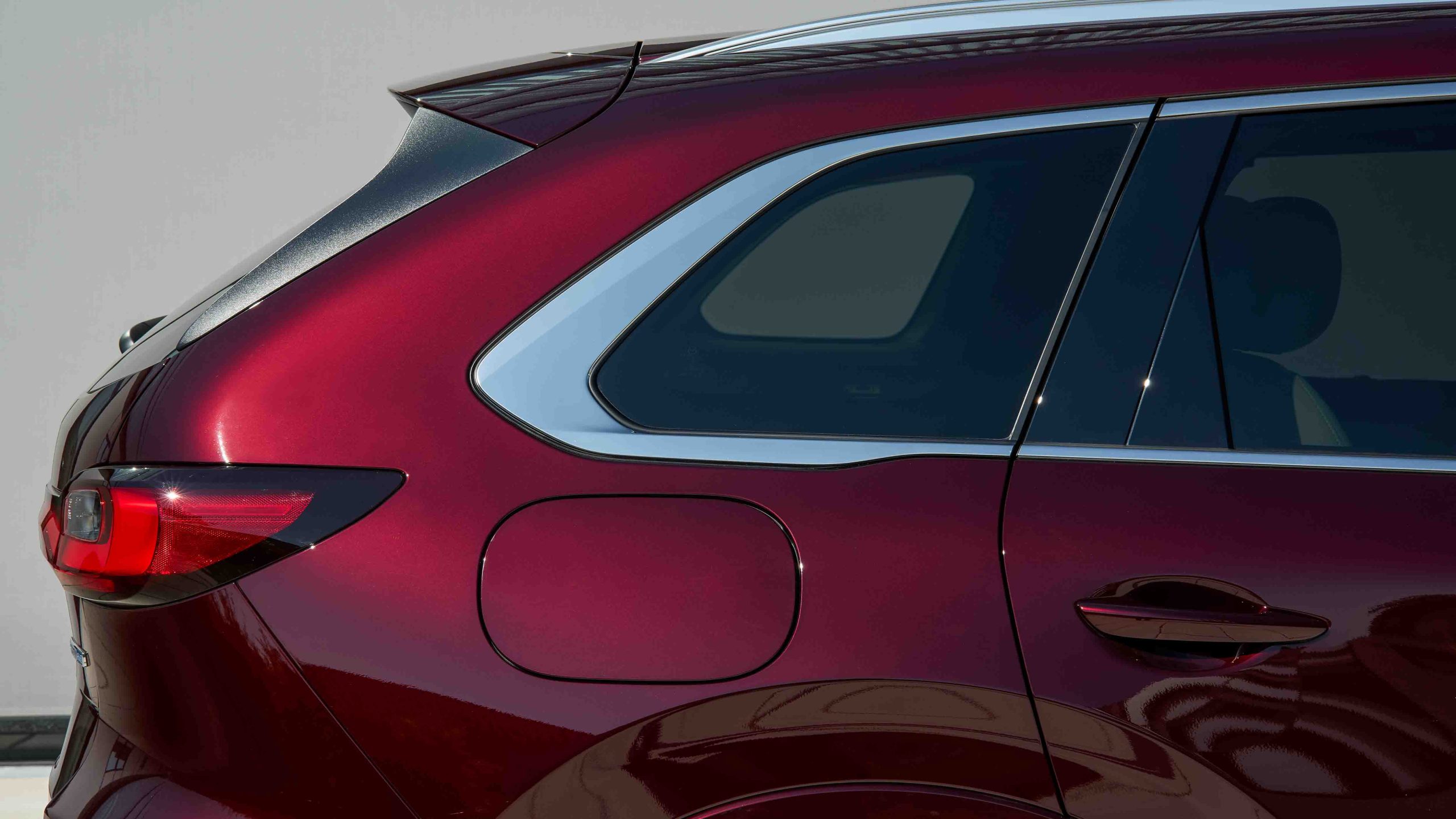
It’s worth pointing out that the closely related Mazda CX-60 scored the maximum five-star rating in ANCAP testing but lost some points because reversing AEB (back-over protection) is optional on the entry version.
Exact local CX-80 safety spec is yet to be confirmed.
The honest verdict on the Mazda CX-80
Given the shared DNA of the CX-60 and CX-90, we weren’t surprised to find the CX-80 has a similarly attractive combination of strong, sporty and efficient engines, coupled to a smooth and responsive transmission.
We also love the premium interior and overall excellent levels of quality and technology which also carry over from the new-generation SUV models already on sale in Australia.

But after some criticism of the initial CX-60 and CX-90 suspension tuning when both models arrived in Australia, we’re impressed that Mazda has taken all feedback onboard and rolled out some changes for the CX-80 (as well as the related CX-60).
While the slightly fussy secondary ride is not yet completely resolved, there are significant improvements to the primary ride and overall comfort.
With the best ride of the lot, the full suite of engines to choose from, and a seven-seat cabin, this latest CX model is the most complete in a growing SUV family at the larger end of Mazda’s expansive range.
Toyota Camry 2024 review
1 year ago

Dylan Campbell
Contributor
Toyota’s ninth-generation Camry sets a new benchmark for sedan fuel efficiency, recording 3.8L/100km on-test – even if its price continues to creep up
Good points
- Outstanding hybrid fuel efficiency
- Sparkling dynamics offer handling fun
- Decent ride quality and refinement
- Massive boot space
- Cheap servicing costs
- Excellent Toyota hybrid system
Needs work
- Big price increases in recent years
- Requires premium fuel
- Could use more rear foot space
- CVT still an uninspiring transmission
- Hybrid…or nothing
In the not-too-distant past, 0-100km/h was the hottest set of numbers in the motoring world, but as vehicles have become quicker, and basic physics has enforced the law of diminishing returns, it’s been easy to lose interest.
Now there’s a new set of numbers to watch – one that might have you experiencing a sudden bout of narcolepsy, though the engineering involved is just as exciting: litres per 100km.

Against a backdrop of a heating planet, regulations that seek to replace the combustion-engined vehicle with an electric one, and even geopolitics, this figure has become newly relevant. Lawmakers around the world want to eliminate L/100km altogether, and head straight to kWh/100km in one uncomfortable leap.
But Toyota argues there’s still plenty of room to reduce fuel consumption in combustion-engined vehicles in the meantime – sneaking an important interim chapter into the story of reaching zero carbon emissions.
The new-generation Camry, which has just arrived in Australia, demonstrates as much. Its 2.5-litre naturally aspirated four-cylinder engine is paired with an electric motor in classic Toyota hybrid fashion to deliver an official combined fuel economy figure of 4.0L/100km. In our own testing, as you’ll read later, we managed to best even that, without trying.

Part of its superb efficiency, quite aside from Toyota’s well-honed hybrid system, is its shape. It’s as if someone has taken an SUV, lowered it and its roofline to reduce the frontal area, subsequently improving aerodynamics – and fuel economy. This new, lower and sleeker type of SUV, one also popularised by the Tesla Model 3, is called a sedan and it might just take off.
Toyota says the ninth-generation Camry is all-new, but it’s effectively a heavy facelift of the previous XV70 Camry and its GA-K platform. While new front and rear bumpers (and mostly new exterior styling) extend its length by 35mm, the width, wheelbase and height remain unchanged.
There’s a new interior, Toyota’s latest active-safety technology, and updated powertrains, with the XV80 Camry range now being hybrid only.
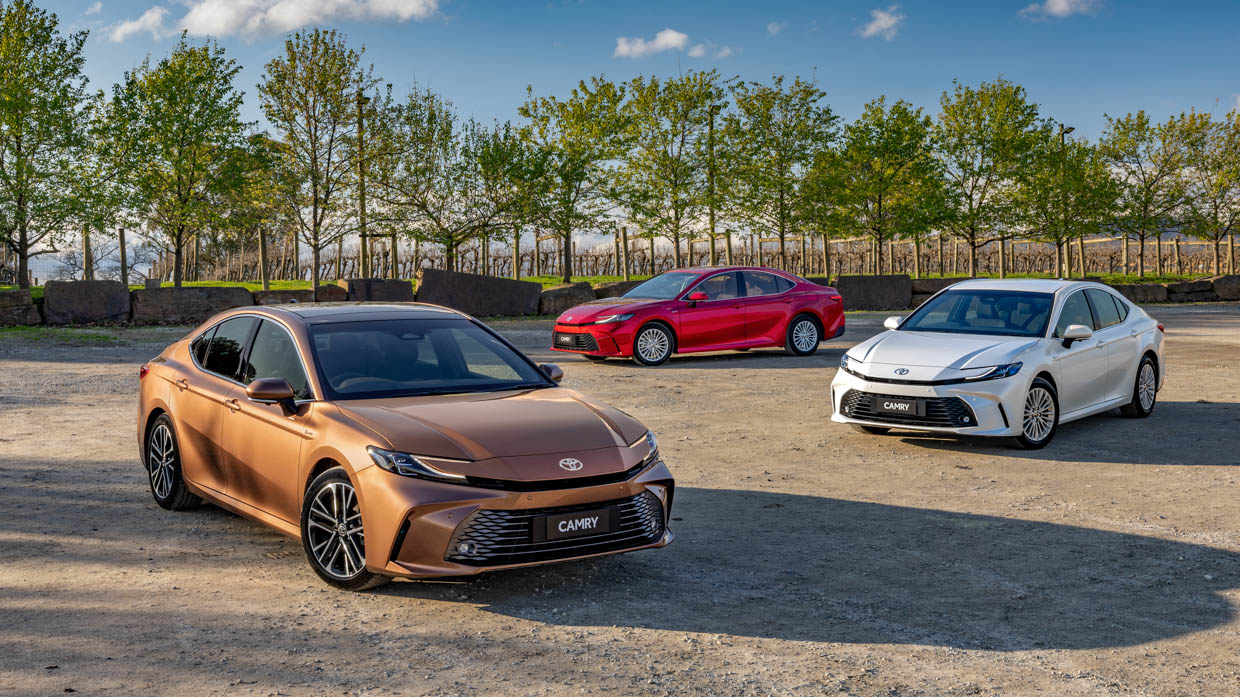
Prices have crept up considerably in just a handful of years. In 2020, the Ascent, Ascent Sport and SL hybrid grades of the previous Camry cost $31,790, $33,790 and $42,790 respectively (before on-road costs).
Now, the base Ascent is almost as expensive as the top-spec SL cost back then, kicking off the range at $39,990. The Ascent Sport, meanwhile, is $42,990 while the SL has jumped to $53,990.
For a segment comprising just 15,134 sales last year, medium sedan rivals under $60,000 are numerous. There’s the new-generation hybrid-only Honda Accord, the concept-car-looking Hyundai Sonata and the ageing Skoda Octavia and Mazda 6.
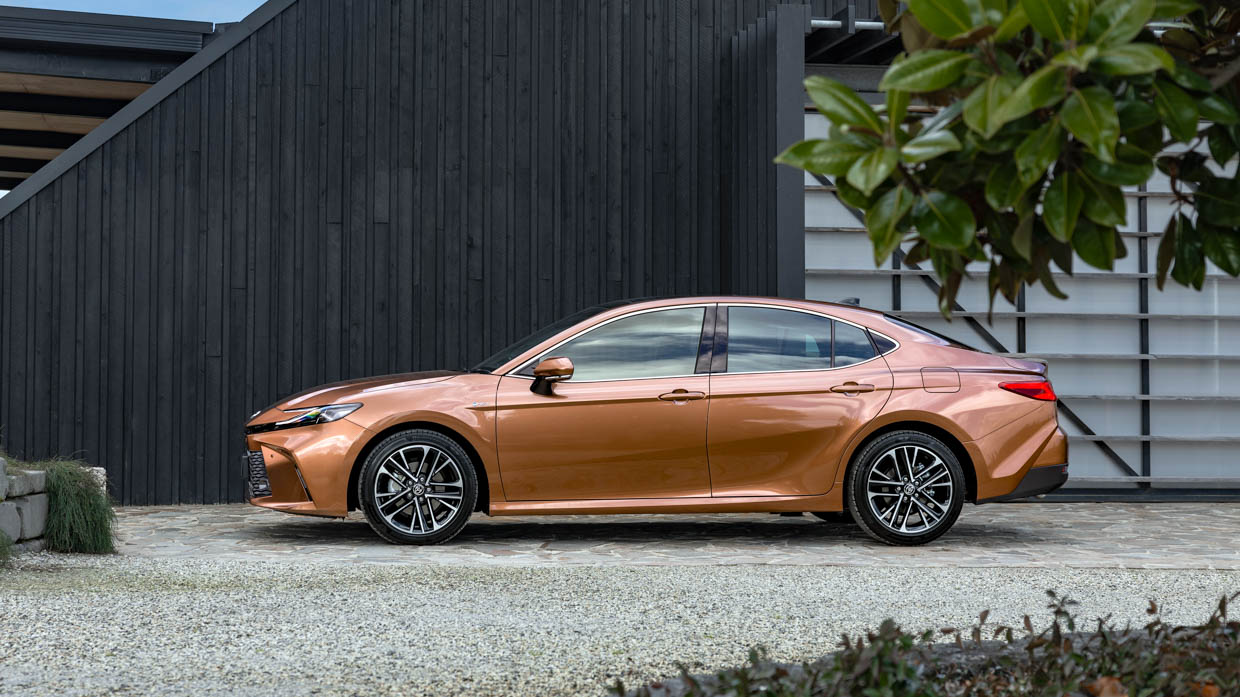
We’re sure the electric BYD Seal and evergreen Tesla Model 3 have also pinched a few would-be Camry buyers in recent times – though perhaps that may change with this sophisticated new hybrid-only generation.
What are the Camry’s features and options for the price?
There are three Camry grades – the base Ascent, mid-spec Ascent Sport and top-spec SL. Today we’re driving the Ascent Sport.

The entry-level Ascent is a real rideshare-market special. Standard equipment highlights for the $39,990 Ascent include:
- 138kW/221Nm 2487cc naturally aspirated four-cylinder engine
- 100kW/208Nm permanent magnet synchronous motor
- 4Ahr lithium-ion hybrid battery
- Continuously variable automatic transmission (CVT)
- Cloth upholstery
- Manual front seats
- Urethane steering wheel
- Dual-zone climate control
- Keyless entry and start
- 7.0-inch digital instrument display
- 8.0-inch infotainment touchscreen
- Wireless Apple CarPlay/wireless Android Auto
- DAB+ digital radio
- Six-speaker sound system
- 17-inch alloy wheels
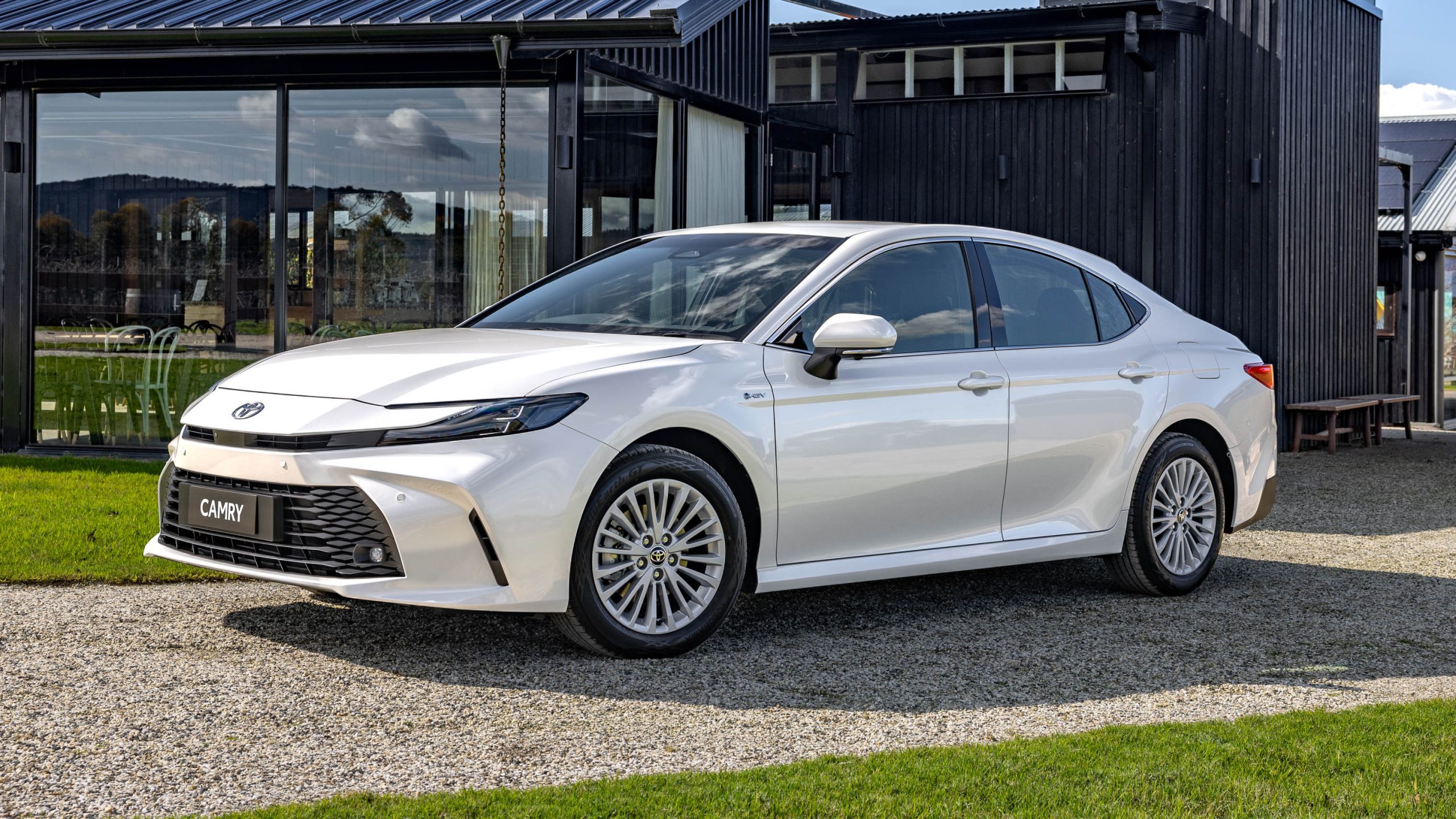
The Ascent Sport includes a few niceties for private and fleet buyers. For an extra $3000, it adds:
- LED headlights
- Eight-way electrically adjustable driver’s seat
- Leather-accented steering wheel and shift knob
- Auto-dimming rear-view mirror
- 15-watt wireless phone charger
- 12.3-inch infotainment touchscreen
- In-built satellite navigation
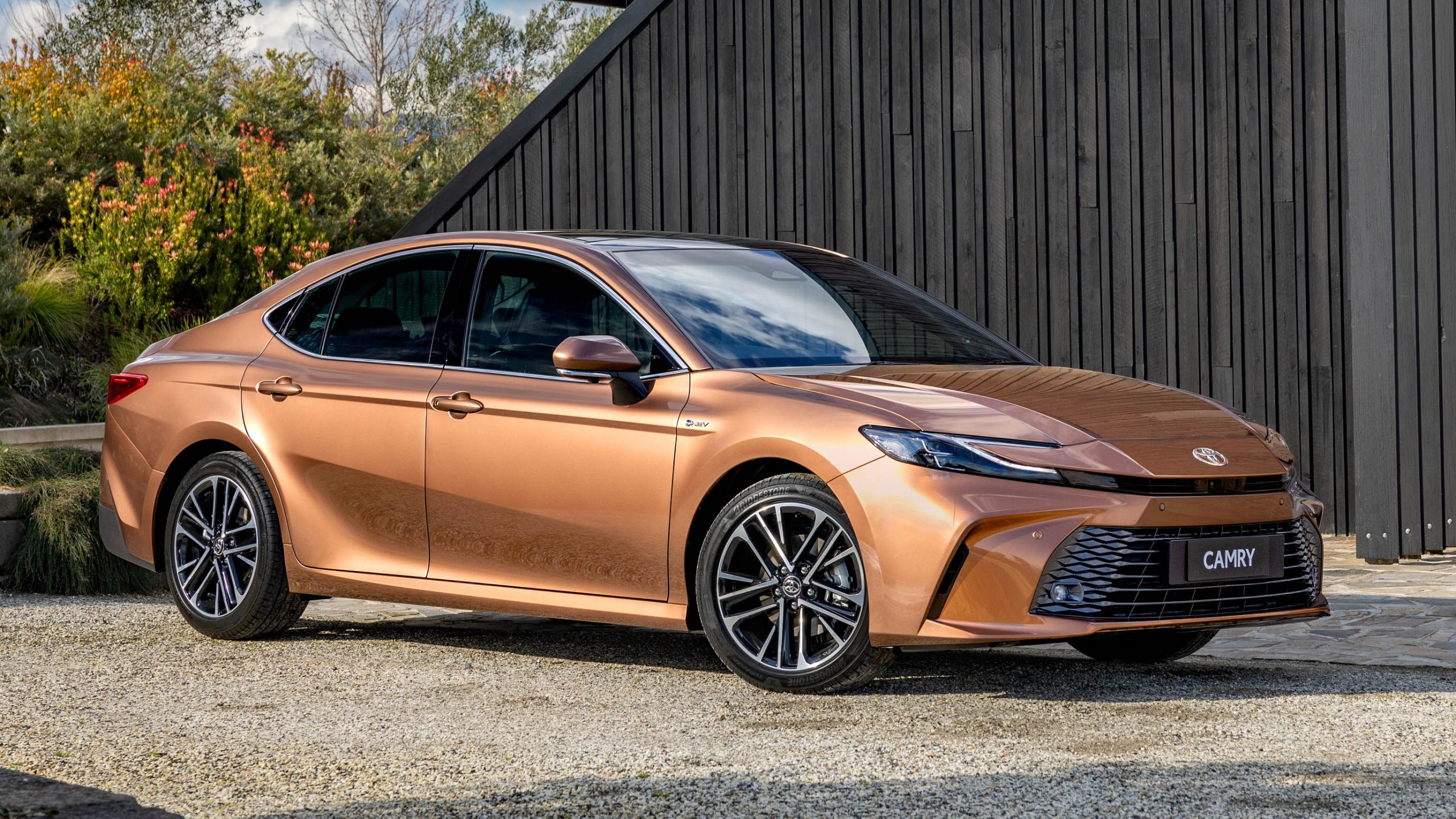
The flagship SL is $11,000 north of the Asecnt Sport, and adds luxuries including:
- Unique 18-inch alloy wheels
- Rain-sensing wipers
- Rear privacy glass
- Heated wing mirrors with reversing tilt and memory
- Leather-accent upholstery
- Eight-way electric front passenger seat
- Front seat heating and cooling
- 12.3-inch instrument cluster
- Heated steering wheel
- Electric steering-column adjustment
- Panoramic sunroof
- Nine-speaker JBL audio system
The new Camry comes with connected services (an in-built SIM card), the first 12 months of which is complimentary. After that, you’ll need a subscription.
From a styling perspective, we think this isn’t a bad-looking car. The ‘hammerhead’ front design language gives it a modern, sleek appearance, and it’s curious that there are no hybrid badges. Toyota calls this, at least by way of its exterior badges, an “HEV” – a hybrid electric vehicle.
How does the Camry drive?
The new Toyota Camry is a very nice, very grown-up vehicle to drive, with impressive levels of comfort and refinement.
In the urban environment, it’s reasonably quiet and smooth, while the powertrain transitions from petrol to electric-only (almost) imperceptibly. The passive suspension is quite soft, helping the Camry glide over most bumps very comfortably.
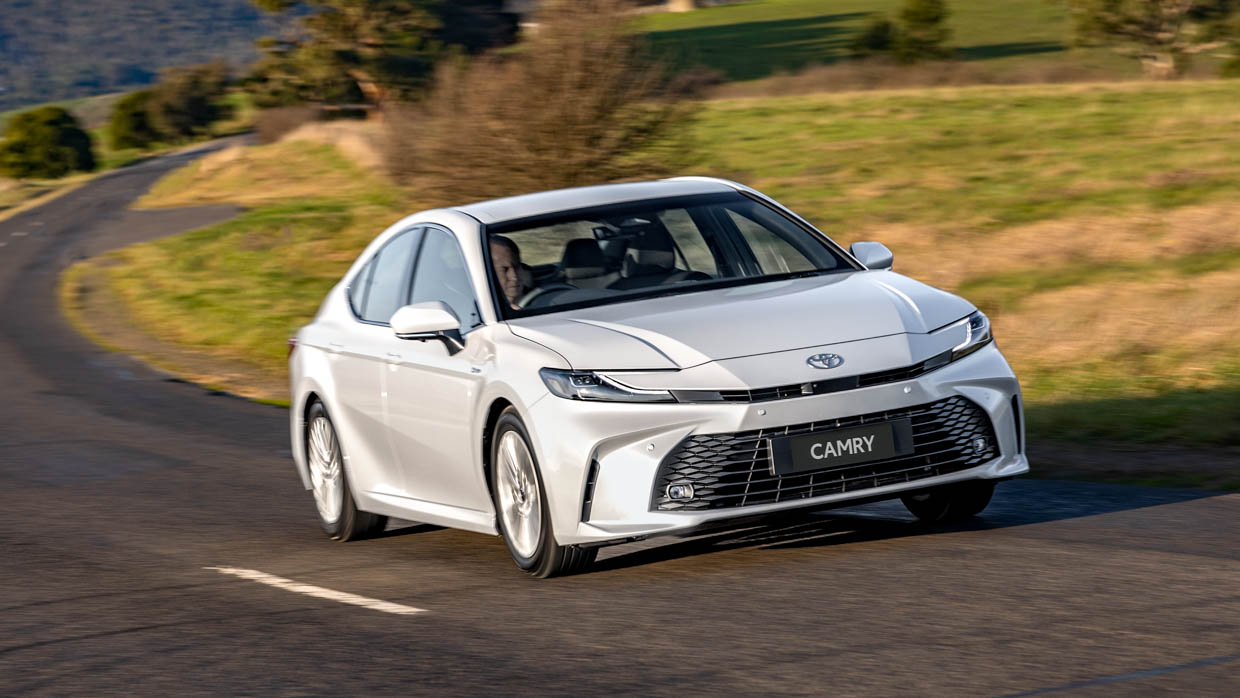
All the controls are light and easy to use, and offer a decent amount of feel. Power has also increased by 10kW compared to the previous hybrid Camry, now 170kW combined from both combustion engine and electric motor.
Put your foot down and the power is solid, if not scintillating. You can feel the 100kW/208Nm electric motor instantly responding to your throttle input with its sudden torque, while the CVT fixes the revs of the four-cylinder engine in the upper ranges, loudly groaning in its power sweet spot.
Toyota claims the new Camry Hybrid can do 0-100km/h in 7.2 seconds. Fast? Not particularly. But easily quick enough for most buyers.
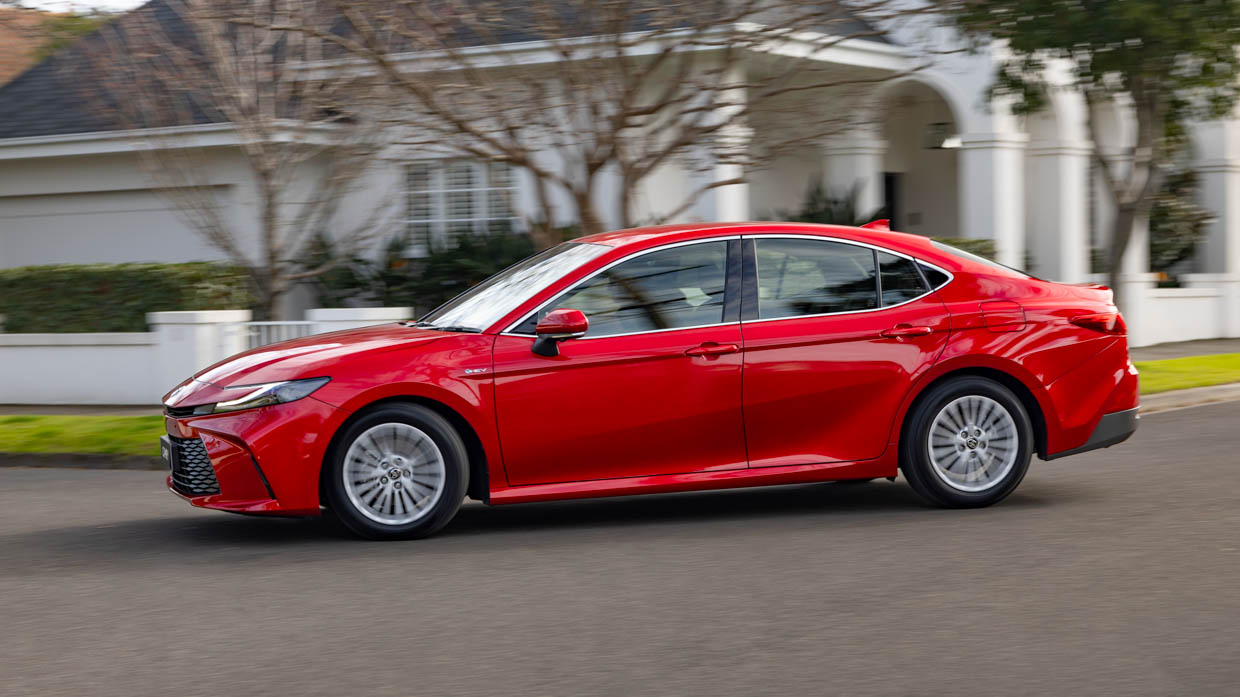
The handling, however, is surprisingly good – fun, even. At 1565kg, this is a relatively light car by modern, mid-size sedan standards, and it shows in the corners, which the Camry relishes. The steering is sharp and direct, while there’s a glimmer of dynamic magic to hint that the Camry comes from the company that makes the GR86, GR Yaris and GR Corolla.
This is no doubt helped by its multi-link independent rear suspension. It’s as if, when developing the Camry, Toyota left itself the opportunity to create a GR version (with a spicier powertrain) – if the mood ever took.
There’s a bit of body roll, but for the most part the Camry feels composed, confident and fluid when driven hard. It’s a pity the powertrain isn’t a better companion. In Sport mode, this efficiency-focused powertrain attempts its best sports-car impression, but the CVT transmission ultimately reduces the engine’s potential, making it merely a thing of function.

The new Camry is a car that thrills in a different way: adjusting the digital instrument cluster so you can see the average fuel consumption and driving as delicately as possible to get that number down. And it rewards, as our real-world 3.8L/100km figure attests.
While the lithium-ion battery is only 4Ahr in capacity, you can select an “EV Mode” and potter around on light throttle loads, at low speeds, using nothing but energy that would have once been lost as heat in the brakes.
It doesn’t turn the Camry into a plug-in hybrid lite, but you could feasibly complete an entire lap of an unventilated underground carpark emitting no harmful exhaust fumes whatsoever – if that kind of thing appeals.
What is the Camry interior and tech like?
The Ascent Sport’s cabin is a spacious and comfortable place to be, even if the materials feel pretty ‘fleet’ in this grade with its cloth-upholstered seats. That said, a little bit of leather on the steering wheel and shift-knob goes a long way. It’s good leather, too.
The driving position is classic sedan, seating you reasonably low (especially compared to an SUV) and with your legs outstretched.


You get a good amount of tech by way of the larger 12.3-inch touchscreen, wireless smartphone mirroring and wireless phone charger. The Apple CarPlay integration fills the centre screen, and we appreciate the retention of hard buttons for the heating and cooling controls. A merciful decision for those who must spend long seat time.
Front seat storage space is pretty good with a large centre console, although the smaller door bottle holders are a bit last decade. It would have been nice to see Toyota resculpt the door bins to fit bigger drink bottles, again given this is an office for many drivers.
For the most part, the back seat feels identical to the old Camry. There’s a good amount of space (as you’d hope) and decent amenity including a centre armrest, dual manual air vents and two USB-C outlets.
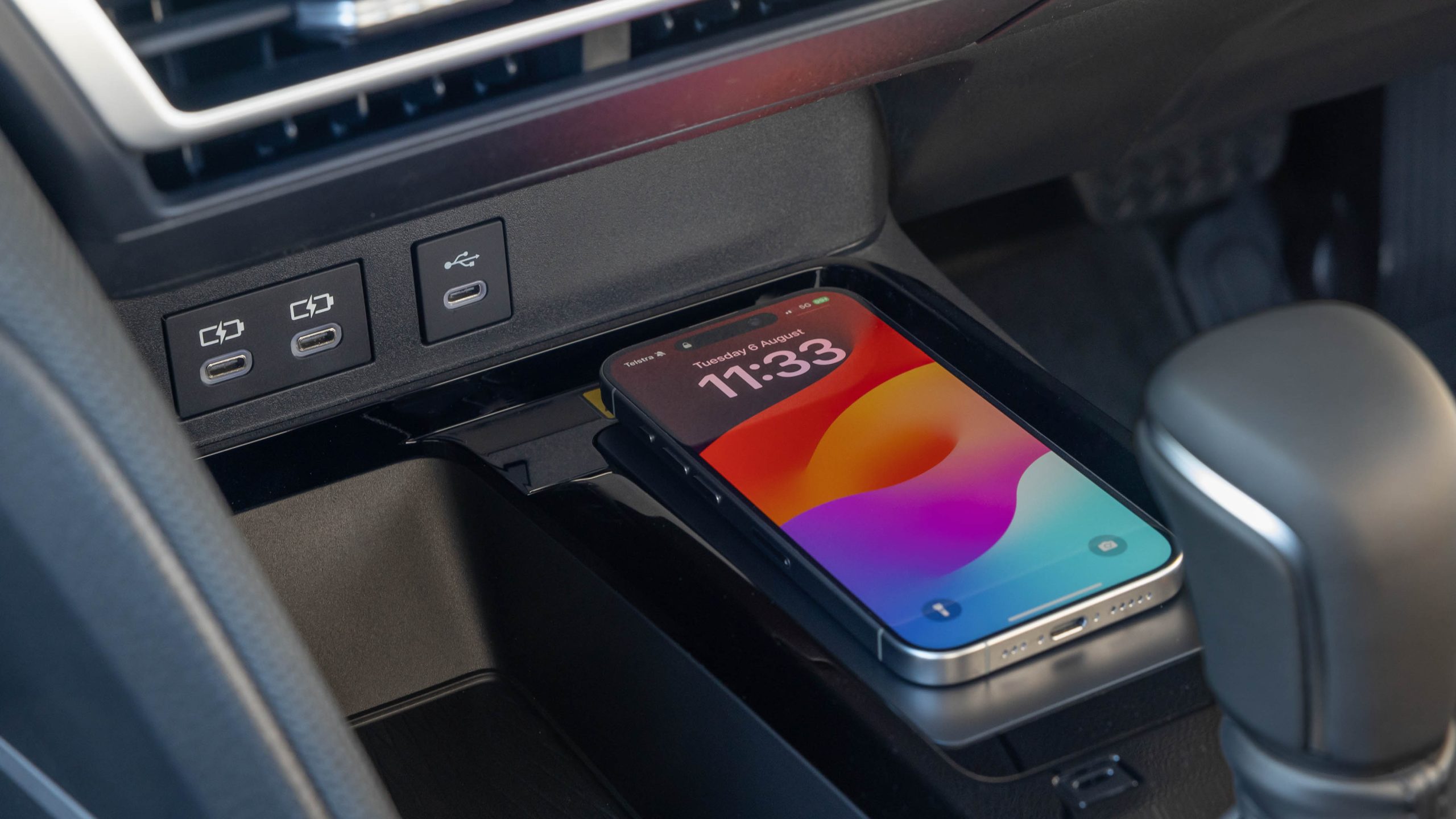
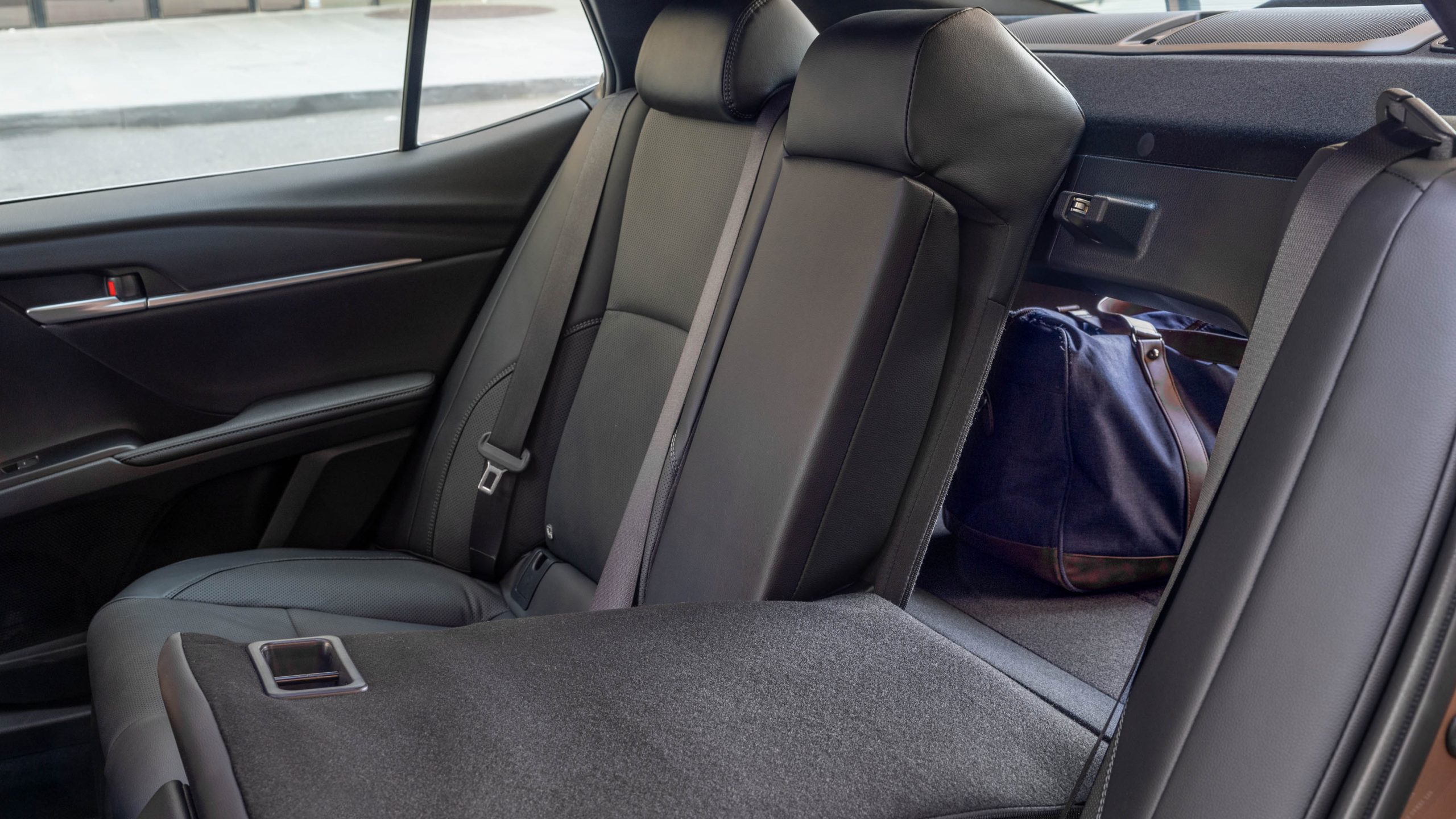
There’s plenty of knee-room but there could be more foot-room for a car that probably accepts more rear passengers in the world than any modern equivalent.
To that point, we would have loved to see some more improvement or innovation for rear-seat passengers, but alas not. Far more people will experience the back seat of the new Camry than the front, after all.
There are two sets of ISOFIX points on the outboard rear seats, and three top-tether anchorages.
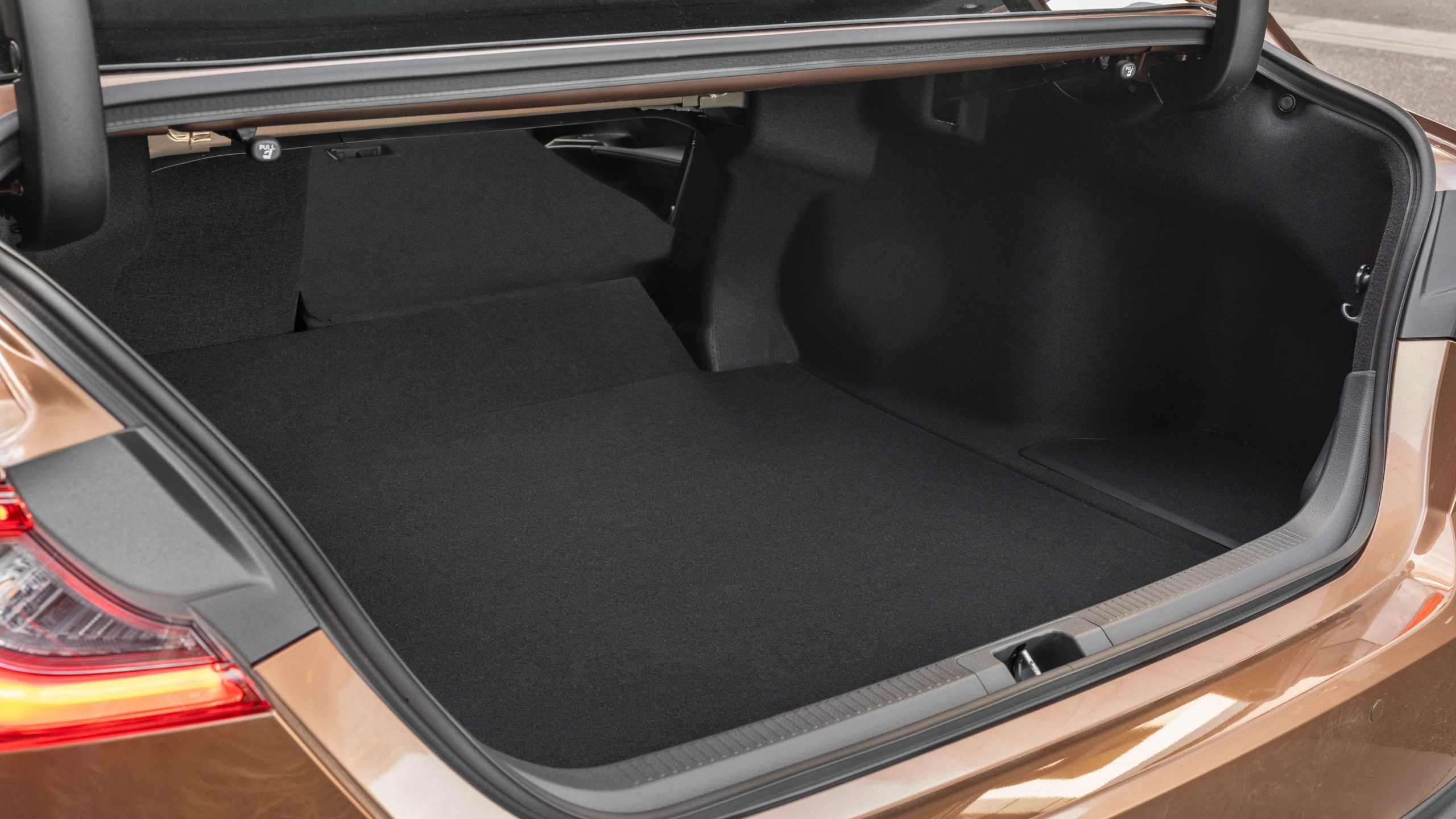
Moving to the boot, and it’s truly impressive for a mid-size sedan. The boot opening itself widens like it’s trying to eat the world’s largest suitcase in one gulp, while its 524-litre volume means it might just fit. There’s a space-saver spare wheel and, pleasingly, two boot-situated levers to fold down the 60/40 split-fold rear seats.
Overall, the Camry Ascent Sport’s interior has a workmanlike vibe, but it feels engineered to meet the basic needs of style – while being able to last for many hundreds of thousands of kilometres. It would be a comfortable place to spend a long time, which is surely music to the ears of most of its eventual drivers.
Is the Camry a safe car?
The new Toyota Camry is very safe – as was recently proven in independent crash-testing by the Australasian New Car Assessment Program (ANCAP).
Its score of 95 percent for Adult Occupant Protection is the highest ANCAP has recorded – which is no small deal. For child occupant protection it scored 87 percent, while vulnerable road user protection was 84 percent, and safety assist was 81 percent.
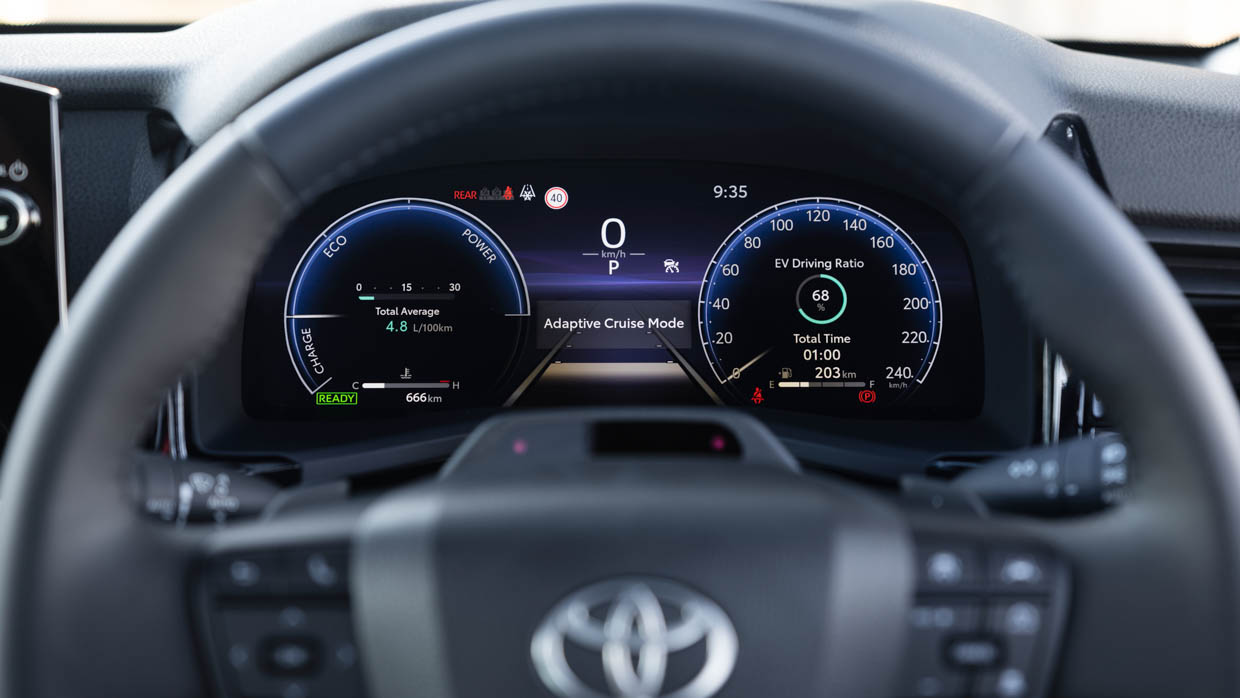
As well as seven airbags including a front-centre airbag, all Camry grades come with Toyota’s latest active-safety technology – dubbed Safety Sense in Toyota-speak – including:
- Autonomous emergency braking with motorcycle, pedestrian and (daytime/night-time) cyclist detection
- Intersection collision avoidance with pedestrian and oncoming vehicle detection
- Adaptive cruise control
- Active lane keeping
- Lane departure warning
- Speed-limit sign detection
- Driver attention monitor
- Automatic high beam
- Blind-spot monitoring
- Safe exit assist
- Front and rear parking sensors
- Reversing camera with rear cross-traffic alert
- Rear autonomous emergency braking

The Camry’s in-built connectivity provides the ability to automatically contact an emergency call centre in the event it detects a collision – for a little extra peace-of-mind. All active safety systems worked well during our testing without being annoying or intrusive.
What are the Camry’s ownership costs?
The Toyota Camry would be a cheap car to own and run.
Of course, its headline act is its fuel economy, and as previously mentioned we recorded a best of 3.8L/100km over mixed suburban and freeway driving, and we weren’t even trying that hard. Something like 3.6L/100km might be possible – or even lower again.

With its 50-litre tank, it’s theoretically possible to extract more than 1300km of range, which is incredible! Unfortunately, to get that fuel economy requires pricier 95RON premium unleaded petrol.
Maintenance is also moderately pricey at $255 per service. Intervals are every 12 months or 15,000km, giving a five-year total servicing cost of $1275, which is enticing.
At least with a Camry in the driveway, you can sleep soundly when it comes to depreciation (now there’s a sentence to get the blood pumping). In an era where depreciation is the biggest cost to owning an electric vehicle, retained value is a proven Camry strength.

According to AutoGrab, which captures resale data from the biggest online automotive marketplaces in Australia, the Camry ranked 17th for residual value in 2023. The Camry retained an average of 79.1 percent of its value after three years and 45,000km.
The base Ascent hybrid was a star performer, retaining 81.4 percent of its value over the same period and mileage, which matches the best-performing vehicle for retained value in Australia in 2023 according to the survey, the Nissan Leaf.
The honest verdict on the Camry
There are more exciting mid-size sedan options than the new Toyota Camry – we can’t imagine many owners taking their new car around to show their mates – but this stalwart sedan remains one of the most practical vehicles you can buy today. And it just strengthened its grip on that title even further.
Toyota would hate for us to say it, but there’s no getting away from the fact that you might feel like an Uber driver in the front seat of the Camry Ascent Sport. If you’re a private buyer, it’s worth stumping up for the richly equipped Camry SL just to evade this feeling.
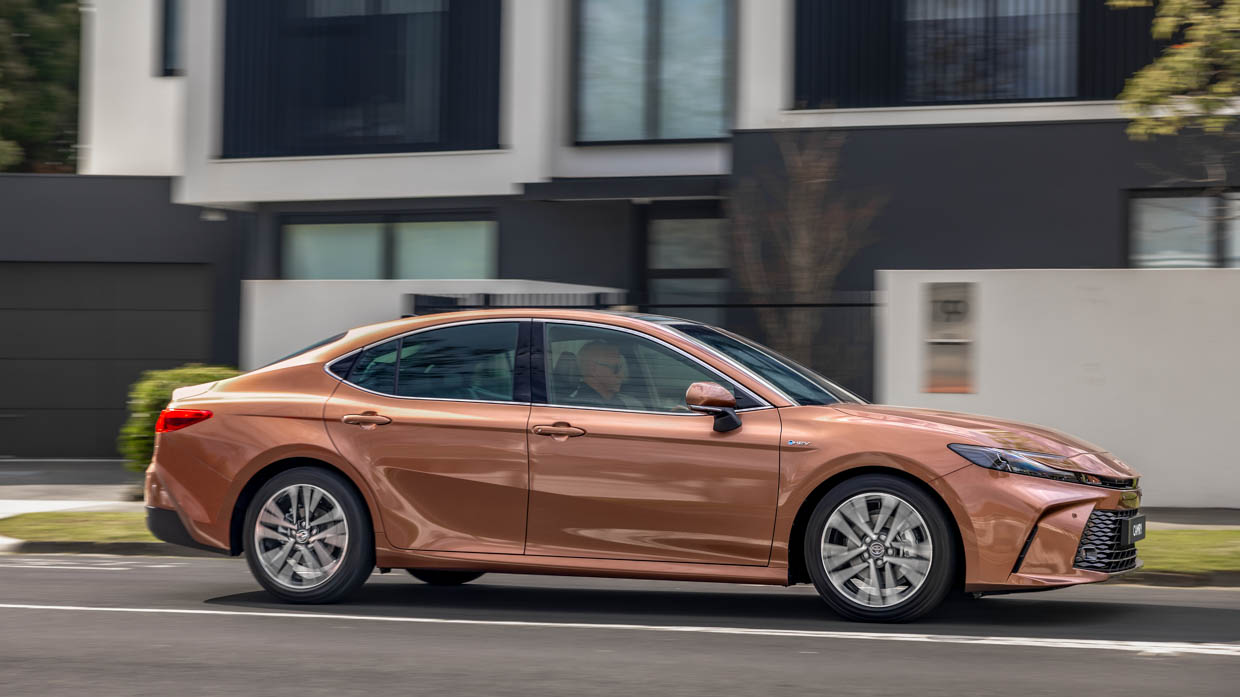
It’s also a pity the price has gone up so much, dramatically eating into any savings yielded by the new Camry’s outstanding fuel efficiency. Toyota should be a champion of the people in the fight against rising living costs. Yet we’re left to assume the cost to create the car itself has risen. At least the new all-hybrid Camry should hold onto its value well.
In the grand scheme of things, it’s surprising the Toyota Camry isn’t more popular. It’s a difficult car to fault – comfortable, easy to drive, spacious and with a huge boot. And the hybrid fuel efficiency is really something, going to show L/100km and the engineering involved really can be as interesting as acceleration times. Or almost, at least.



